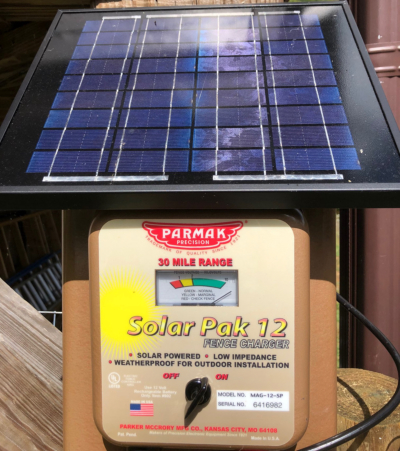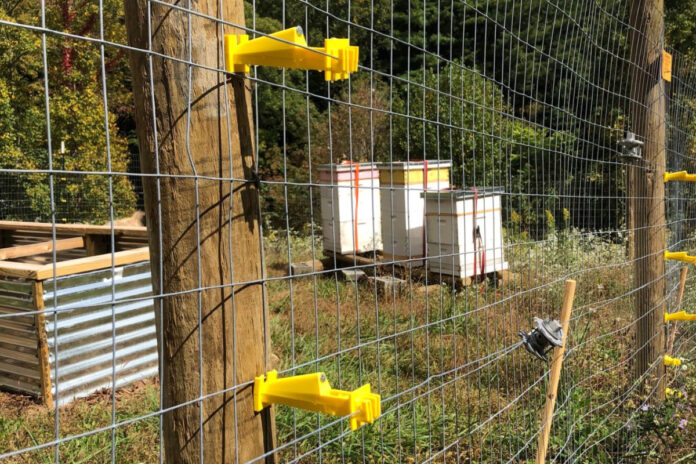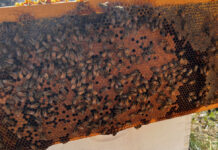Back on September 15, I documented how I had screwed up my electric fence install, primarily through inexperience. Since then, I bought larger plastic insulators. Then I disassembled and rebuilt the electric fence. I pounded a few stakes in to ensure the new wires that did not come close to grounding out on the welded wire fence behind it. Then I carefully inspected each run of wire before I turned on the energizer. Not even a sizzle or a crackle. The electric fence still did not work.
I caved in and bought an electric fence tester. Instead of more than 10,000 volts, my fence was carrying less than 500, the lowest setting on the tester. When I got shocked while using the tester, it was a barely noticeable tingle. I disconnected the fence from the energizer and tested it. It was working fine. The problem was still on my end.
After doing some online research, I learned that grounding is often a problem, so I installed a second ground rod. It took something like fifteen tries to pound in the first one, so I was not looking forward to it, but installation went quicker this time. I found a soft spot in the ground without rocks on only my third or fourth try. I pounded it in, wired it up and tested the fence. The fence still does not work. I now have two ground rods, even if I didn’t need them. But there is no doubt—that fence is grounded!
Working Backwards
I carefully disconnected each wire and tested them one at a time until I identified the bad run. Of course, it was the first run I did and the last one I checked. Note to self: Next time, check each wire as I go. In took a careful look at the entire run and it looked just fine. Hmm.
I had used metal fence ratchets to tighten the wire. Maybe, I thought, the ratchet was interfering with the flow of electricity. I disconnected the ratchet and tied the wires together. It was still bad. OK, so it wasn’t the ratchet.
Before I finished hooking the ratchet backup, I noticed the wire leading to the ratchet had the full charge. But when I hooked the other section to the ratchet voltage dropped off. Something on the latter half of this wire was causing it to ground out.
When an electric fence is close to a ground, but not quite touching, it snaps and crackles like static electricity when you touch a doorknob. But when it is touching a ground, you don’t hear or see anything and the voltage just disappears into the ground. Apparently, that’s what happening on that last strand of fence.
An Invisible Problem
I could see no problem. I pulled the wire off of all the insulators and inspected it, but I still could not find the problem. After I re-strung it, I flipped on the energizer, and dang if the fence still did not work. Frustrated, I finally replaced it with new wire, using new pieces of black insulation for the corner posts. Viola! Problem solved. The system worked. I hooked up the other wires, and the voltage stayed up. Whew!
I took a closer look, and I believe the black tubing that was used as an insulator on the corners had gotten scraped open when I tightened the ratchet. Apparently, the ratcheting had dragged the black plastic tube against the underlying fence, creating an opening where it was grounding out.
In any case, we are back up and running, the electric fence not only installed but pumping out a full 10,000-plus volts. It’s a month past my original deadline and it cost be about $80 in new insulators and the tester, but it’s done. The bees should be protected from a bear and the chickens from coyotes or any wild or stray dogs.

So far, there’s been no sign of a bear, but like a good prepper, I prefer to prepare for the worst rather than crossing my fingers or thinking “It can’t happen to me.”
As I build up the bee yard, the potential savings of not having a bear tear apart my hives will be well worth the expense, time, and effort. And the fence is expandable. If I expand the bee yard beyond the ten or twelve hives that would fit in there now, I can just add more wire. If we decide to raise rabbits, I can run a few strands in front of their hutches.
The principals of building an electric fence are pretty straight forward. If I ever have an out yard (a bee yard at a different location), I will use a much simpler installation with no welded wire fence.







